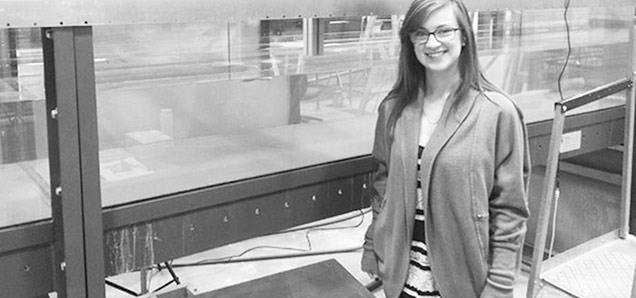Engineering student reconstructs plesiosaur fins
 CREDIT: BRAD KENNEDY
CREDIT: BRAD KENNEDYThe plesiosaur is possibly getting an update thanks to Laurel Richards.
EDMONTON (CUP) - Laurel Richards is reverse-engineering a plesiosaur.
No, this isn't some twisted, Jurassic Park-style experiment destined to go wrong. Richards, a fourth-year civil engineering student, is sticking to plastic models in her search to discover how the creature functioned in its natural habitat.
As part of a research collaboration between University of Alberta professor Mark Loewen and Donald Henderson, curator of dinosaurs at Alberta's Royal Tyrell Museum, Richards has been experimenting with a one-tenth scale model of the ancient reptile — the plesiosaur isn't actually a dinosaur —to determine the arrangement of fins on the creature's body that would have allowed it to swim stably in its turbulent, freshwater environment.
To do this, Richards and Loewen have been using an open-channel flume to simulate the same conditions a plesiosaur would have been exposed to millions of years ago, when it roamed the lakes and rivers of the world. The device used in their research is essentially a glass-walled artificial river that allows the researchers to observe the behaviour of their model underwater in real time.
“It's basically an aquatic lizard; this plesiosaur would have been about three meters long,” Richards said. “Henderson's theory is that plesiosaurs wouldn't have been able to swim with stability — to maneuver, turn and stay swimming forward — without some sort of fin on their tail. With their long necks and their flippers, they wouldn't have been able to move as effectively.”
Their research is still in the early stages, but Loewen and Richards are working to investigate the theory that the addition of a wide fin at the end of the plesiosaur's tail would act like a rudder on a boat, giving the lizard greater control and balance in its movement. Right now, Richards says the tail-less model they've been running tests on has difficulty staying oriented forward.
“We'd like to do more tests on plesiosaurs with tail fins, and possibly with larger models,” Richards said. “Our current equipment doesn't include a load cell sensitive enough to measure the torque created by the model in the simulation. If we can quantitatively determine the torque, we can then start to see if a tail fin creates more stability for the model, numberswise.”
In the meantime, Richards is working on developing new and inventive approaches to the research while Henderson constructs new models to test in the lab. She's attempted various reconfigurations of the single model they have so far, removing and reattaching the tail fins to observe how that affects the positioning of the plesiosaur underwater.
Other engineers at the university have suggested experimenting on a model of a sea turtle, because of the similarities between the flippers of turtles and plesiosaurs. There are plenty of directions research could take from here, and Richards said she considers the experience of working in this lab an interesting departure from her normal studies as a civil engineer.
“I couldn't pass up looking at this old aquatic reptile,” Richards said. “When I read what the research would involve, I contacted Dr. Loewen, and we set it up ... It's definitely been a big learning experience for me.”













